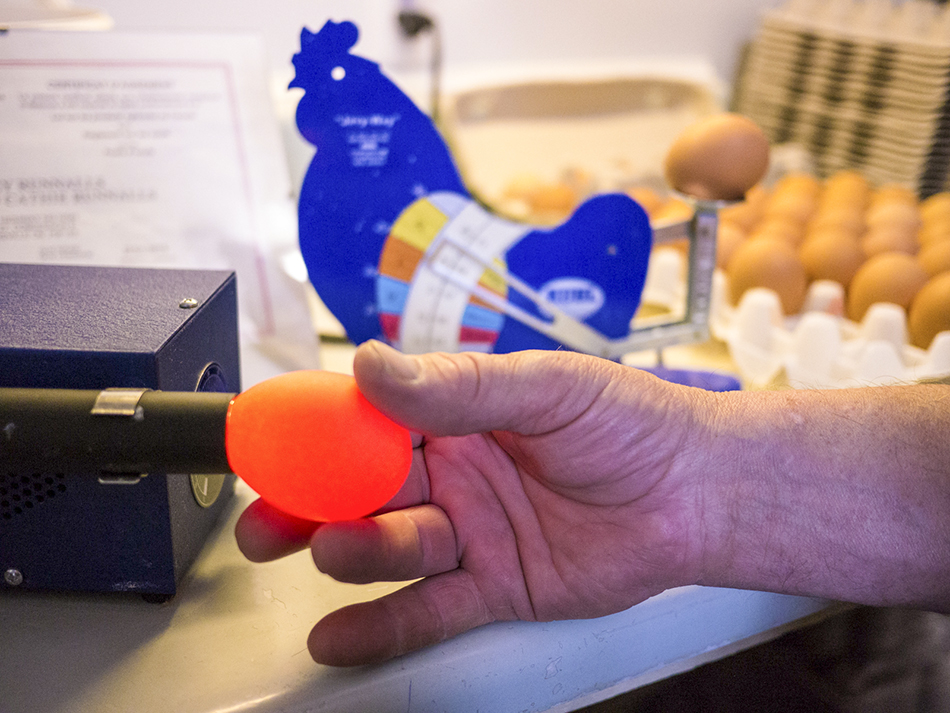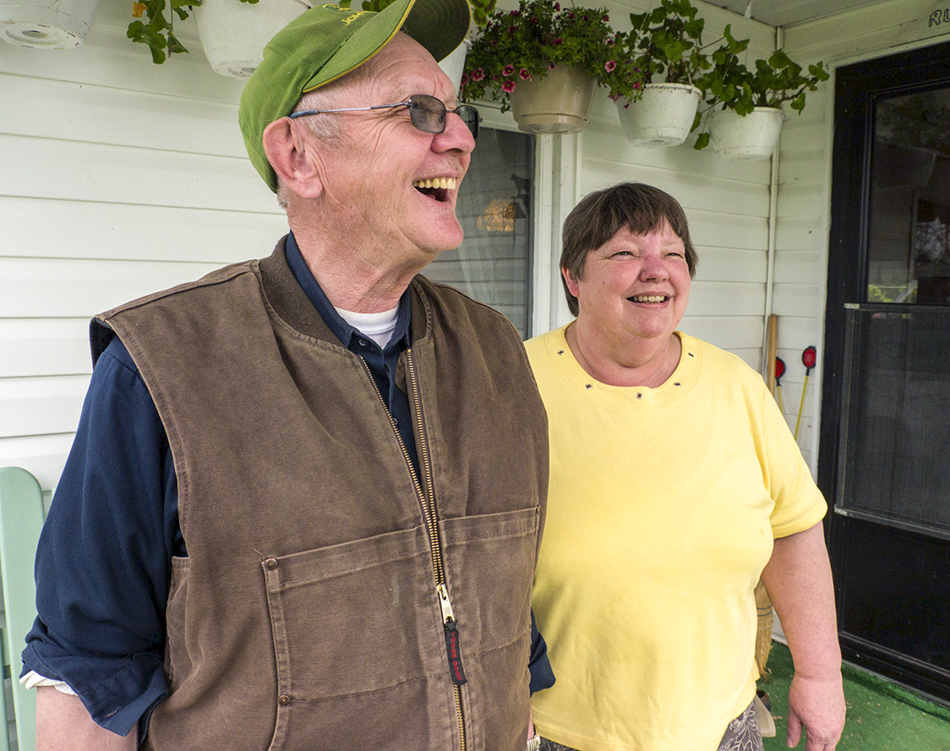by Isobel Harry
EVANSVILLE— If there’s something Morley Runnalls doesn’t know about egg production, it’s probably not worth knowing. He could no doubt tell you exactly which, the egg or the chicken, came first and precisely why the chicken crossed the road! The Evansville farmer, who has raised chickens for 60 years, and who opened Manitoulin’s only egg-grading station with his wife Cathie in January of this year, is knowledgeable about how much protein there is in an extra-large egg (seven grams) or any size egg, and about how to stack eggs in a carton (air pocket-side up, that’s with the more ‘pointy’ end down). He can also recognize if an egg is rotten from 50 paces, and advises to keep eggs in the fridge no more than six weeks.

photos by Isobel Harry
Did you know that regular supermarket eggs keep longer because each egg is oiled to keep air out? That white eggs take less time to process than brown because you can see through them more easily? That you get more brown than white eggs per hen? Morley and Cathie Runnalls know.
Starting up an egg grading operation was a natural extension of the Runnalls’ many years raising laying hens and selling eggs at their farm gate. They own between 400 and 500 birds and grade 150 dozen eggs a week in their new facility. “Each hen,” says Mr. Runnalls, “lays about 320 eggs a year. They are bred specifically to produce eggs, which we gather twice a day. That’s not nearly enough for all the customers who want fresh, local eggs.” Mr. Runnalls delivers eggs to Little Current, Birch Island, M’Chigeeng, Mindemoya and Gore Bay stores and recently added Manitoulin Meats to his client list after the Providence Bay store approached him at last week’s Manitoulin Trade Fair. “My eggs are distributed on the Island first, and the surplus goes to Massey and Sudbury—more eggs are sold in Sudbury than on Manitoulin,” he says.
Before the Runnalls opened their egg-grading station, Morley would drive to Walford on the North Shore once a week to grade their hens’ output. “Before that, I used to have to go to St. Mary’s, in southern Ontario, to grade them. I’d get $1.38 a dozen for them, and 38 cents of that went to the egg marketing board. The nearest station now is in New Liskeard, and there’s a place near the Soo, but that’s it, there are no other grading stations in this area.”
The Runnalls’ facility took a year and a personal investment of $15,000 to set up. Mr. Runnalls is proud that “no government funds whatsoever” were obtained to build it. “It’s all our own money,” he adds. The station could not be in their home a stone’s throw away because it has to be open to inspection by Canadian Food Inspection Agency (CFIA) inspectors anytime, year-round. The whole room had to be cleanable easily, so the Runnalls covered the walls and ceiling of the tidy space adjacent to the barn in metal sheets and washable paint, double insulated for warmth in winter; it’s a “dry station” where the eggs are cleaned by brushing rather than by running water, but still there had to be hot and cold purified running water (there’s a UV and grey water system) in case someone needed to wash their hands.
Other strict rules of the CFIA stipulate that there must be two refrigerated coolers in an egg-grading facility, one for graded eggs and the other for ungraded, kept below 10 degrees centigrade. Temperatures must be recorded twice a day in a ledger and be below 85 percent humidity. Egg cartons must be new, never recycled, and labeled with egg size, name, address and ‘premises code’ of the producer and nutritional information, in French and English. In the centre of the label is an outline of a maple leaf with the grade of egg contained in the carton. Grade A means the eggs are free of blemishes and cracks and are clean. Factors also governing this grade include the size of the air pocket (“not in excess of 5 mm in depth”) and the texture of the shell. Mr. Runnalls illustrates by holding up an egg whose shell doesn’t make the grade, but only he can detect the minute bumps that most could not see with the naked eye. “It’s all about cleanliness and safety,” he says. “Twenty percent of eggs are not grade A and can’t be sold.”

Canada Food Inspection Agency (CFIA). Married in 1975, the Runnalls have “always” had laying hens to supply locals and visitors with farm-fresh eggs. Now, the CFIA certification means their eggs can be enjoyed all over the Island and beyond.
Hens are bought at 19 weeks of age when they’re ready to lay. “You can only keep hens for 12 months,” says Mr. Runnalls, “then their laying life is over.” When eggs are gathered, they are brought into the station, where each is cleaned and ‘candled’ with a variable high-intensity light to determine its condition for market, including possible defects and size of air pocket. ‘Candling’ is the original term for looking into the contents of an egg because back then it was done with the flame of a candle. Today, the main requirement is a bright light with a beam smaller than the diameter of the egg, and a dark room. Morley switches off the overhead light and the egg turns bright orange and transparent. “The light needs to be more intense for brown eggs than for white, which are more easily seen through.”
Each egg is weighed and put into the appropriate labeled carton which is then stamped with the best-before date, six weeks away. “I keep records of dates and temperatures for traceability of the eggs. Once a customer buys my eggs, if anything is not right, or if there is a recall, the eggs can be traced back to me. So far, this has not happened.”
Manitouliners are fortunate that Morley and Cathie Runnalls are up with the chickens every day, putting all their eggs in one basket so we can enjoy fresh, local graded produce right here on the Island. It’s really something to crow about.




